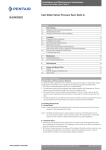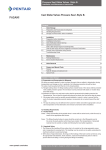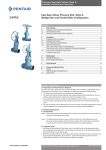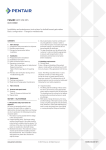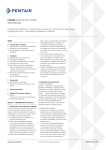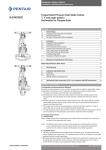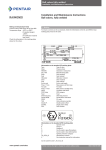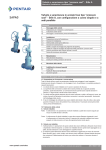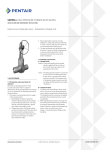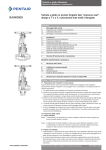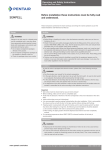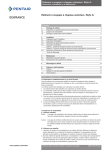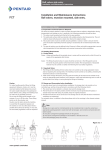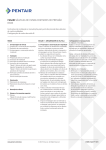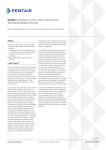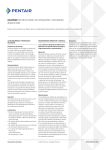Download Dewrance Gate Valves, Cast High Pressure Style A
Transcript
Sempell Dewrance Pressure seal gate valves - Style A Installation and maintenance instructions Cast gate valves pressure seal - Style A Wedge gate and parallel slide configuration 3.All actuated valves must be carefully securely palleted or crated, in order to ensure that the parts of actuator (especially pneumatic piping or accessories) do not extend beyond the skid/crate. 4.The type of packing must be defined in the Customer’s Order and shall be appropriate to ensure safe transportation to final destination and eventual conservation before installation. 1.2 Handling requirements A - Packed valves Crates:Lifting and handling of the packed valves in crates will be carried out by a fork lift truck, by means of the appropriate fork hitches. 1 Valve storage Cases:The lifting of packed valves in cases should be carried out in the lifting points and at the center of gravity position which have been marked. The transportation of all packed material must be carried out safely and following the local safety regulations. 1.1 Preparation and preservation for shipment All valves are properly packed in order to protect the parts that are subject to deterioration during transportation and storage on site. In particular, the following precautions should be taken: 1.The valves must be packed with the wedge in the closed position. 2.The weld ends surface shall be protected with suitable protective like Deoxaluminite. The end shall be closed with plywood or plastic disc fixed at the edge by strips. B - Unpacked valves 1.The lifting and the handling of these valves has to be carried out by using appropriate means and at respecting the carrying limits. The handling must be carried out on pallets, protecting the machined surfaces to avoid any damage. 2.With valves of large dimensions, the sling and the hooking of the load must be carried out using the appropriate tools (brackets, hook, fasteners, ropes) and load balancing tools in order to prevent them from falling or moving during the lifting and handling. www.pentair.com/valves © 2012 Pentair plc. All Rights Reserved. VCOSI-01413-EN 15/05 Sempell Dewrance Pressure seal gate valves - Style A Installation and maintenance instructions Figure 1 Valve slinging 1.3 Storage and preservation before installation In case the valves have to be stored before installation, the storage has to be carried out in a controlled way, and has to be performed in accordance with the following criteria: 1.The valves have to be stocked in a closed, clean and dry storage room. 2.The wedge must be in the closed position, and the end faces must be protected with plastic or wooden discs fixed with straps. If possible, keep the original protection. 3. Periodical checks have to be carried out in the storage area to verify that the above mentioned conditions are maintained. For actuated valves, in addition to the above, please refer to the warnings in the manual of the actuator. Warning! Storage in an open area for a limited period can be considered only in case the valves have appropriate packing (packed in cases lined with tarred paper, and contents well protected with barrier sacks). Do not place consignment packages directly on the ground. Do not expose consignment packages to the weather or directly to the sun. Check the packaging every two months. Caution For valve handling and/or lifting, the lifting equipment (fasteners, hooks, etc.) must be sized and selected while taking into account the valve weight indicated in the packing list and/or delivery note. Lifting and handling must be made only by qualified personnel. Do not use the lifting points located on the actuator, if any, to lift the valve. These lifting points are for the actuator only. Caution must be taken during the handling to avoid that this equipment passes over the workers or over any other place where a possible fall could cause damage. In any case, the local safety regulations must be respected. 2 Installation 2.1 Preparation before installation 1.Carefully remove the valve from the shipping package (box or pallet) avoiding any damage to the valve or, in case of automated valves, to the electric or pneumatic/ hydraulic actuator or instrumentation. 2.Clean the inside of the valve using an air line. Ensure that there are no solid objects such as pieces of wood, plastic or packing materials within the valve or on the valve seat. 3.Confirm that the materials of construction listed on the valve nameplates (service and temperature) are appropriate for the service intended and are as specified. 4. Define the preferred mounting orientation with respect to the system pressure. If any (see arrow on the body), identify the upstream side (high pressure) and downstream side (low pressure). Warning! Verify that the direction of the flow in the line corresponds to the arrow indicated on the valve body. Valves without the arrow are bi-directional. See the actuator user manual for the actuator preparation. 2 Sempell Dewrance Pressure seal gate valves - Style A Installation and maintenance instructions Figure 2 Installation positions recommended 10° 10° . ax °m 90 2.2 Installation Instructions Gate valves are normally installed in horizontal pipe with vertical stem. These valves can also be installed in vertical or horizontal pipe with stem other than vertical, but this may require special construction depending on valve size, service condition, material and type of operator. For a correct operation, Dewrance recommends that the valve shall be installed and oriented following the indications of Figure 2. This can help minimize any problem associated with solid particles present in the fluid that otherwise could deposit in the lower part of the body and be obstacle to the wedge complete closure. Unless otherwise recommended by Dewrance, the valve should be installed with the wedge in the closed position, to ensure that the seat ring in the wedge is not damaged during installation. Particular care should be taken with those valves equipped with ‘fail-open’ actuators. For operating temperatures above 200°C (392°F) thermal insulation of the valve body is recommended. Handling and lifting of the valves during installation MUST be performed following the same criteria and instructions described in previous points “1.2 Handling requirements” and “1.3 Storage and preservation before installation”. Important After the valves installation and before the line testing, it is recommended to perform an accurate cleaning of the lines to eliminate dirt and any foreign objects that could seriously jeopardize the tightness between seat/disc and the correct operation of the valve. 2.3 Valve verification before start up 1.Tighten the packing just enough to prevent stem leakage. Over-tightening will decrease packing life and increase operating torque. The bolt torque figures for the packing bolts can be calculated as indicated in Table 1. 2.Check the operation of the valve by stroking it to “full open” and “full close”. 3. If the valve has been stored for a long time, check the bolt torque for bolting (pos. 31) in accordance with Table 2. 2.4 Operations instructions 1.Style A Series gate valves do not require special care to work properly. The following instructions will help provide a satisfactory and long life service. 2. Make sure to perform periodic valve verification as described in Paragraph 2.5. 3. In case of actuated valves always follow the specific instructions given by the actuator’s manufacturer. 4.Never change the setting of torque and/or limit switches which have been carefully set during the final test at Dewrance workshop. Important If piping system is pressurized with water for testing, and in case the piping system has been shut down after testing for a long time, the following recommendations should be adopted. a. Use corrosion inhibitor with water to pressurize the piping system. b. After testing, the piping system should be depressurized and the test water completely drained. Buttweld valves Position the valve and check the alignment with the pipe, then proceed with welding, in accordance with the applicable welding procedure. 3 Sempell Dewrance Pressure seal gate valves - Style A Installation and maintenance instructions Table 2 - Bolt torque to ensure Tightness of Pressure Seal Gasket Table 1 - Bolt Torque Figures for Packing Bolts For system pressures < 2533 psi Torque (ft·lbs) = (24.87) x (OD2 _ ID2) x (d) Torque (Nm) = multiply torque (ft·lbs) x 1.3558 For system pressures ≥ 2533 psi Torque (ft·lbs) = (S.P./101.8) x (OD2 _ ID2) x (d) Stud ⅜ ½ ⅝ ¾ ⅞ 1 1⅛ 1¼ 1⅜ Where: OD = Stuffing box bore (in.) ID = Stem diam (in.) d = Gland stud diam (in.) S.P.= System pressure (psi) This “Torque method” may result in more or less than 30% compression. 2.5 Periodic valve verification during service A - Normal check 1.Verify monthly that there is no leakage from packing or in the body/bonnet area. If the leakage has been detected from the packing, tighten nuts according to the procedure described in Section 3. If the leakage does not stop, follow the procedure for packing maintenance (3.1). If the leakage has been detected from the body/bonnet, tighten the nuts (pos. 31) as indicated in Table 2. If the leakage does not stop, follow the maintenance procedure for the replacement of the body/bonnet gasket (3.2, 3.3). 2.Every 2/3 months, depending on operating frequency, verify the greasing of bearings and stem thread. 3. For actuated valves, in addition to the above, please refer also to the warnings in the actuator manual. Troubleshooting guide Symptom Stem packing leaking Body-bonnet leaking Valve leaking Jerky operation Back seat leaking B - Preventive actions 1.Every 3 months verify the tightness of gland bolts. 2.Every 6 months on motorized valves and every 8 months on hand operated valves, grease stem and bearings. 3.Every 12 months check the travel of the gland follower, setting a new packing when the end of the travel is approaching. 4.Every 4 years disassemble the critical service valves and/or actuated valves, verifying the sealing surfaces and lap them again when necessary. Substitute the bonnet gasket and the packing, grease the stem. 5. For the actuator, proceed as indicated in its maintenance manual. Possible cause 1. Gland flange nuts too loose 2. Packing damaged 1. Gasket bolting loose (pos 31) 2. Gasket damage 1. Valve not fully closed 2. Debris trapped in valve 3. Sealing surface damaged 1. Packing is too tight 2. Air supply inadequate (for pneumatic act.) 1. Back seat damage Position 31 for gate valves Torque ft·lbs Torque Nm 18 24.5 37 50 74 100 125 170 207 280 310 420 443 600 627 850 811 1100 Important To ensure tightness of pressure seal gasket, pull up bolts must be tightened when valve is under fully hydrostatic test pressure. Solution 1. Tighten gland flange nuts 2. Replace packing (see Paragraph 3.1) 1. Tighten bolting (pos 31) 2. Replace the gasket 1. Close valve 2. Cycle and flush (with valve open) to remove debris 3. Recondition the seat surface 1. Loosen gland nuts, cycle the valve, retighten 2. Increase air supply pressure 1. Replace the back seat 4 Sempell Dewrance Pressure seal gate valves - Style A Installation and maintenance instructions 3 Maintenance The Style A Series Valves have been designed to require minimum maintenance. This manual describes on site repairs as: - Packing replacement - Body/bonnet gasket replacement All the other repairs should be performed by Dewrance or Nominated Service Company. 3.1. Packing maintenance If leakage is observed through the packing, tighten the gland nuts slowly and evenly until the leakage stops. Caution Do not over-tighten packing gland nuts. Over-tightening will increase the torque required to operate the valve. When tightening the gland nut, use half-turn increments until leakage has stopped. Please refer to Figure 4 To replace the packing proceed as follows: Warning! Before starting any maintenance, depressurize, drain and vent the line; check that the valves are not in temperature; disconnect any electrical power supply. Failure to do so may cause serious personal injury and/or equipment damage. 4.Remove the worm-out packing using a hooking wire. 5. For a better tightness, proceed to an accurate cleaning of the stem and stuffing box and make sure there are no scratches or signs of seizing. 6.The repacking shall be carried out by placing one ring at a time around the stem, inside the stuffing box and by making sure that they are correctly oriented. Press it into the bottom (refer to Figure 3). 7.When the stuffing box is filled, replace the gland (9) and gland flange (10) in their original position. 8.Tighten gland nuts in accordance with Table 1 (bolt torque figures for packing bolts). 9.Cycle the valve. 10.Pressurize the line. 11.If a leakage is detected, tighten the gland nuts slowly and evenly until the leakage stops. Figure 3 3.2 Bonnet gasket replacement Warning! Before starting any maintenance, depressurize, drain and vent the line; check that the valves are not in temperature; disconnect any electrical power supply. Failure to do so may cause serious personal injury and/or equipment damage. 1. Braided graphite 2. Die formet graphite (5 or 6 ring) 3. Metal ring Figure 4 1. Open completely the valve up to the backseat position. 2.Remove the nuts (16) of the gland bolts (15). 3.Lift the gland flange (10) and the gland (9). 5 Sempell Dewrance Pressure seal gate valves - Style A Installation and maintenance instructions Figure 5 Lifting lugs for DN = 6” For DN = 4” Please refer to Figure 5 1.Unscrew the body bonnet nuts (pos. 12) and the gland nuts (pos. 16) 2.Lift up the yoke (pos. 24) operating by the handwheel or gearbox handwheel 3.When the stem nut is free from the stem threads, lift up the yoke. 4.Unscrew the nuts (pos. 31). 5.Remove the retaining ring (pos. 311). 6.Remove the segment rings, push them out from the body groove by using the body holes placed radially on the top of the body. 7.Lift up the bonnet (pos. 6) and pressure seal body gasket (pos. 5). Make sure not to damage the packing. We suggest to replace the packing when changing the body gasket. 8.Carefully clean all the gasket housing and lubricate with suitable grease. 9.Replace the body gasket. 10.Reassemble all parts following backwards the above mentioned steps. 2.The pipe shall be cut as far away from the valve as possible. 4 Valve removal 5.2 Special tools No special tool required for the maintenance operation described in this manual. If the valve needs to be removed from the line for some extraordinary reason, the user should ensure the following: 1.The valve is depressurized, drained and vent. For DN = 3” 5 Greases and special tools 5.1 Greases To lubricate the bearings on manual and gearbox operated valves, we suggest to use the grease AGIP GRMUEP2 or an equivalent product, as showed in Table 3. For the lubrication of the stem thread, use the grease SIGNAL CEP 30 produced by Viscol. As an alternative you can utilize: - CEPLATTYN 300 produced by REINER-FUCHS - GRAFLOSCON produced by KLUBER You can also use a grease having more than 25% pure graphite content (carbon 98%) granulometry 5 m, without any abrasive agent. For the lubrication of the actuator, refer to the relevant manual. Caution The nuts (pos. 31) need to be retightened after valve first pressurization, as indicated in Table 2. Table 3 - Grease and lubricant list Manufacturer AGIP API BP ESSO FINA MOBIL Q8 SHELL TEXACO TOTAL VISCOL STATOIL Grease GRMUEP2 PGX2 GREASE LTX2 BEACON 2 FINAGREASE HP FINAGREASE EPL2 MOBILUX EP2 REMBRANDT EP2 ALVANIA R2 SUPERGREASE A MULTIFAK EP2 GREASE L2 MULTIS EP2 MULTIS 2 SIGNAL ROLSFER 2 UHIWAYLI LI G2 6 PENTAIR VALVES & CONTROLS www.pentair.com/valves All Pentair trademarks and logos are owned by Pentair plc. All other brand or product names are trademarks or registered marks of their respective owners. Because we are continuously improving our products and services, Pentair reserves the right to change product designs and specifications without notice. Pentair is an equal opportunity employer. © 2015 Pentair plc. All rights reserved. 7









